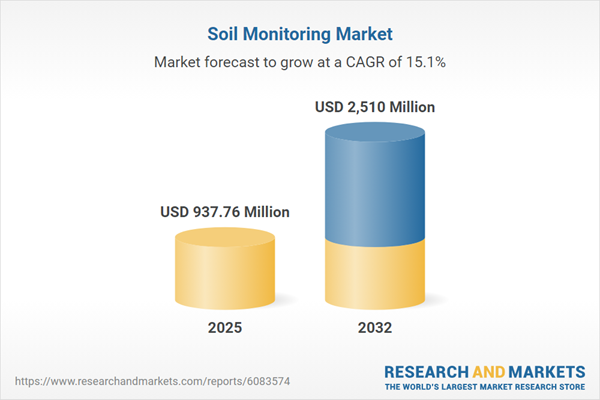Speak directly to the analyst to clarify any post sales queries you may have.
The soil monitoring market is transforming the agricultural sector by delivering data-driven solutions that enhance resource efficiency and help organizations manage risk in a rapidly evolving environment.
Market Snapshot: Soil Monitoring Market Overview
The Soil Monitoring Market grew from USD 816.71 million in 2024 to USD 937.76 million in 2025. It is expected to continue growing at a CAGR of 15.07%, reaching USD 2.51 billion by 2032. This strong growth trajectory highlights increasing global focus on precision agriculture, the need for reliable data in managing soil health, and technological advancements across sensing, connectivity, and analytics solutions. These factors position soil monitoring as a priority investment for agribusinesses, technology providers, and research stakeholders alike.
Scope & Segmentation
This report provides granular analysis and forecasts across a range of market sub-segments, technology approaches, and competing players, supporting strategic planning and market-entry decisions:
- Product Type: Sensors, Services, Software
- Sensor Type: Capacitive, Dielectric, Optical, Tensiometric
- Connectivity: Wired (Ethernet, USB), Wireless (Cellular, LoRaWAN, NB-IoT)
- End User: Commercial, Farmers, Government, Research Institute
- Regional Coverage: Americas (including North America and Latin America), Europe, Middle East, Africa, Asia-Pacific
- Key Companies Analyzed: Yara International ASA, The Toro Company, Delta-T Devices Ltd, Sentek Pty Ltd, Campbell Scientific Inc., Spectrum Technologies Inc., Stevens Water Monitoring Systems Inc., Irrometer Company Inc., Arable Labs Inc., CropX Technologies Ltd.
Each segment is examined in terms of adoption trends, competitive positioning, and regional market characteristics, providing stakeholders with a clear roadmap for prioritization and investment.
Key Takeaways for Senior Decision-Makers
- Advanced soil monitoring systems help agricultural enterprises move from reactive to predictive management, improving yields and operational efficiency.
- Sensor miniaturization and the adoption of Internet of Things architectures are driving continuous, real-time monitoring even in remote or connectivity-challenged regions.
- Integration with cloud-based analytics and development of modular, interoperable solutions enable scalability and reduce deployment complexity for diverse end users.
- Sustainability imperatives and regulatory standards are amplifying demand for resource-efficient, environmentally responsible practices directly informed by high-fidelity soil data.
- Business model innovations like sensor-as-a-service and pay-per-outcome contracts lower barriers to adoption and democratize access to robust monitoring solutions across commercial and smallholder applications.
Tariff Impact on Supply Chain and Cost Structures
Recent United States tariff measures on electronic components are shifting supplier strategies and cost considerations for soil monitoring stakeholders. Manufacturers are revising sourcing approaches, sometimes relocating assembly operations to avoid tariff zones, and are adopting alternative connectivity protocols to mitigate increased module costs. This environment stresses the importance of flexible, modular solution design and diversified supply chains to preserve price competitiveness and ensure delivery continuity for clients worldwide.
Methodology & Data Sources
This report applies a comprehensive approach, combining in-depth interviews with leading stakeholders in the sensor, service, and regulatory domains, a targeted survey of over 150 end users, and extensive secondary research. Data triangulation and expert review underpin all findings, supporting the accuracy and reliability of segmentation, market sizing, and competitive benchmarking presented for the soil monitoring market.
Why This Report Matters
- Delivers actionable insights to inform procurement, partnership, and technology adoption strategies for senior leaders navigating resource constraints and regulatory demands.
- Facilitates targeted product development and market entry by mapping regional dynamics, end user requirements, and evolving technology standards in the soil monitoring market.
- Equips decision-makers with up-to-date, verified data to support investment prioritization and risk management across the value chain.
Conclusion
Soil monitoring continues to evolve through technological innovation and strategic adaptation, empowering sustainable agriculture and operational excellence. By integrating these insights, organizations can drive improved outcomes and competitive advantage in a rapidly shifting agricultural landscape.
Table of Contents
3. Executive Summary
4. Market Overview
7. Cumulative Impact of Artificial Intelligence 2025
Companies Mentioned
The companies profiled in this Soil Monitoring market report include:- Yara International ASA
- The Toro Company
- Delta-T Devices Ltd
- Sentek Pty Ltd
- Campbell Scientific, Inc.
- Spectrum Technologies, Inc.
- Stevens Water Monitoring Systems, Inc.
- Irrometer Company, Inc.
- Arable Labs, Inc.
- CropX Technologies Ltd.
Table Information
| Report Attribute | Details |
|---|---|
| No. of Pages | 181 |
| Published | October 2025 |
| Forecast Period | 2025 - 2032 |
| Estimated Market Value ( USD | $ 937.76 Million |
| Forecasted Market Value ( USD | $ 2510 Million |
| Compound Annual Growth Rate | 15.0% |
| Regions Covered | Global |
| No. of Companies Mentioned | 11 |









